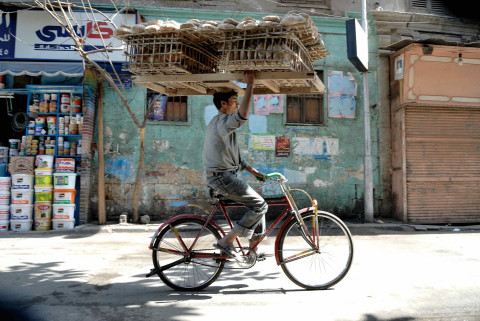The IMF and Ending Energy Subsidies in Egypt A Tale of Class War and Greenwashing
Regions
The IMF’s loans are an obstacle for a just transition in North Africa. In Egypt, the elimination of energy subsidies, a greenwashing strategy and fiscal policies that have failed to reduce inflation reflect a class war against the poor. The longread is structured around three sections. The first section discusses how fiscal consolidation in Egypt has been implemented in a way that has increased inflation in an extremely regressive manner, without achieving significant budget savings. The next section examines why budget savings weren't realized despite major cuts in social spending. It highlights how inflation-control strategies, like raising interest rates in response to measures like ending energy subsidies, strained the budget, leading to a 2% GDP increase in interest payments. The last section looks at realistic alternatives that would both increase macroeconomic stability without low-income households bearing the brunt of the reform and at the same time reverse some of the damage caused by the IMF’s mandated policies.

Illustration by Fourate Chahal El Rekaby
Introduction
The International Monetary Fund (IMF) has been pivotal in shaping economic policy in Egypt over recent years, with Egypt currently the largest borrower from the IMF, second only to Argentina. Whereas in the preceding two decades there were no transactions or agreements between Egypt and the IMF, since 2016 Egypt has signed four loan agreements with the Fund (IMF n.d.).
Despite claims that the IMF has moved away from its previous neoliberal orthodoxy in the aftermath of the 2008 financial crisis—which can also be thought of as a crisis of neoliberalism—extensive evidence suggests that this move has in fact been little more than rhetorical. The IMF still adheres to tight the fiscal, monetary and anti-welfare policies (Diab and Hindy 2021; Mossallem 2016; Kentikelenis 2016; Hanieh 2015) which have been the hallmark of its programmes since the spread of structural adjustment programmes in the 1980s and 1990s in response to the 1980s Global South debt crises.1
Two main pillars have defined IMF programmes in the Global South since the 1980s: one fiscal and the other monetary. The fiscal pillar aims to bring budget deficits under control through what the IMF euphemistically calls ‘fiscal consolidation’ (what critics of such policies often call ‘austerity’). These national budget savings are typically achieved on the expenditure side, through major cuts in social spending and government wages. On the revenues side, they are achieved by increasing the share of regressive consumption taxes (most notably value-added tax (VAT)) in the total tax revenues. The monetary pillar of IMF programmes aims to control inflation. This is typically achieved by significantly increasing interest rates to lower demand and encourage savings, and as a result ‘cooling down’ the economy. The IMF often pushes borrowing governments to limit the expansion of their money supply—that is, available liquid and near-liquid money circulating in an economy—to curb inflation.
It can be argued that the measures under these two pillars made sense in the 1980s, in the aftermath of the 1970s economic crisis, which resulted from the soaring prices of energy after the Arab oil embargo in 1973. In the ensuing Global South debt crisis, most oil-importing Global South countries were running large budget deficits and experiencing high inflation. These measures were also coming after a sizeable expansion of welfare and infrastructure spending in the post-World War II era.
As mentioned above, many studies argue that, despite a change in rhetoric after the 2008 financial crisis, the IMF still follows the neoliberal austerity doctrine manifested in the two pillars of fiscal consolidation and controlling inflation. Unlike in the 1980s, this took place despite not being necessary and after four decades of a heavy attack on the welfare state. While this critique is valid in many contexts, this article goes a step beyond it, arguing that in the recent IMF programmes in Egypt, these two cornerstones of IMF policy have been completely compromised, despite the fact that Egypt and the IMF have adhered to them rhetorically. Instead, the article argues that IMF policies in Egypt do not achieve fiscal consolidation and inflation control, but rather end up inducing not only very high, but also regressive, inflation, meaning that the experience of inflation on average gets more acute as income decreases. As the article argues, these policies also fail, to a large extent, to achieve fiscal consolidation and a lowering of the debt-to-GDP ratio, as well as being ineffective in lowering interest and debt servicing payments, which is a typical professed objective of IMF programmes and the Fund’s fiscal consolidation measures.
The article is structured around the two aforementioned pillars. The first section discusses how fiscal consolidation in Egypt has been implemented in a way that has increased inflation in an extremely regressive manner, without achieving significant budget savings. This is because most of the savings that have been achieved have been generated through ending energy subsidies, which has indirectly led to massive increases in another national budget item: interest expenditure.
The reason why significant budget savings have not been achieved is the focus of the following section, which looks at how inflation-control policies—namely, very high increases in nominal and real interest rates2—responding to the aforementioned inflation-inducing measures (ending energy subsidies) have put extreme pressure on the budget, increasing expenditure by more than 2% of GDP, in the form of interest payments.
The last section looks at realistic alternatives that would both increase macroeconomic stability without low-income households bearing the brunt of the reform and at the same time reverse some of the damage caused by the IMF’s mandated policies.
Fiscal Consolidation or the Diversion of Public Money?
In 2016, the IMF Extended Fund Facility to Egypt—which is the most deep and comprehensive of the four IMF programmes recently implemented in Egypt—had fiscal consolidation as one of its main objectives. For example, the IMF 2016 programme staff report states:
Fiscal consolidation will be underpinned by improved revenue mobilization, including through the new VAT law and better tax administration, and expenditure optimization through PFM [public financial management] measures, subsidy reductions, and the civil service reform. This should ease pressure on the external sector and place general government debt on a declining path to reach 85.8 percent of GDP by the end of the program and decline further to 78.3 percent of GDP by 2020/21. (IMF 2017)
The IMF also argues in the same report that ‘as public debt declines with the fiscal consolidation, so does the interest bill’. The report argues that this ‘will free up fiscal space for higher spending in the authorities’ priority areas of health, education, Research and Development (R&D), investment and social protection’. As we will see, this assessment and prediction could not be further from the truth.
Most fiscal savings under the 2016 programme were achieved by means of ending Egypt’s energy subsidies. Until 2015, energy subsidies were the form of social assistance that took up the most budgetary resources, accounting for about 6% of GDP in 2013, or about a fifth of government expenditure (Diab 2023). By the end of 2019, these subsidies had almost completely ended.
The ending of energy subsidies, with all of its immense social repercussions, was justified on two grounds. The first was that the subsidies benefitted the rich more than the poor since wealthier households use a lot more energy than their low-income counterparts. The second was that the energy subsidies were bad for the environment because cheap energy diverts investment to energy-intensive sectors and promotes the wasteful consumption of fuels (Diab 2023). In the following paragraphs, these two justifications are examined in detail and are assessed in the light of available empirical evidence.

Francisco Anzola/Flickr/CC BY 2.0.
Do universal energy subsidies really benefit the rich disproportionately?
One of the biggest points of contention about energy subsidies is whether they benefit rich households and energy-intensive industries disproportionately. The answer to this question is not straightforward because it varies depending on how we measure the impact of energy subsidies.
First, if we think in absolute terms, there is no doubt that wealthier households use more energy on average; therefore, if energy is universally subsidised these households will be using more of publicly-funded subsidies. The second way of measuring the impact of energy subsidies is relative to total household expenditure. This is usually expressed as a percentage (e.g. 7% of total household expenditure is spent on energy). This approach offers a more useful assessment of the welfare impact of universal energy subsidies.
This is where things start to get a little more complicated, because wealthier households still allocate, on average, a larger share of their total expenditure to energy, but the gap becomes a lot less dramatic than that observed for absolute consumption. For example, a 2015 IMF study shows that in absolute terms, ‘the richest 20 percent of households capture [...] more than six times in fuel subsidies than the poorest 20 percent, making universal fuel subsidies a very inefficient policy instrument for protecting poor households from fuel price increases’. But the same study also shows that, relative to consumption, ‘the total, direct, and indirect welfare impacts are approximately distributionally neutral, with the percentage decrease in welfare [due to elimination of subsidies] being very similar across income groups’ (Coady et al. 2015). In other words, relative to expenditure, households spend similar portions on energy, but since the expenditure of high-income groups is many times higher than that of low-income groups, their energy expenditure will also be many times higher in absolute terms.
Things get even more complicated when we consider energy expenditure relative to income—not total expenditure—since higher-income groups tend to save more of their incomes, while poorer households tend to spend most or all of their income. This means that, relative to income, energy expenditure will constitute a higher share of poor households’ incomes.
Another final variable needs to be considered here, which is related to the way we measure the distributional impact of energy subsidies, and of their removal. This variable is called indirect expenditure on energy, or embodied energy: that is, the energy expended in producing a good or a service and the incurred cost, as reflected in the price of the product. The impact of embodied energy on household expenditure is not minor and cannot be excluded when examining the effects of ending energy subsidies because embodied energy is about three to four times larger than direct energy expenditure (Song 2019). Embodied energy also accounts for a higher share of lower-income households’ expenditure, due to their tendency to spend more of their income, and therefore taking account of embodied energy, rather than just direct energy expenditure, reveals a higher welfare impact of energy subsidies for these households.
In short, when we consider energy subsidies relative to income, and when we factor in expenditure on embodied energy, universal fuel subsidies start to look a lot more progressive and equitable than many neoliberal institutions like the IMF (which often promote targeted cash subsidies as the more equitable option) have suggested. For example, a recently published study by the present author shows that an increase in energy expenditure contributed about 40% of the total increase in living costs in Egypt between December 2015 and August 2019. For extremely poor households, the increase in energy expenditure resulting from the ending of fuel subsidies constituted about 35.7% of their 2015 incomes, whereas for the top income group it constituted only 21.5% (see Table 1).
|
Household income profile |
% increase in energy expenditure to income |
|---|---|
|
Extreme poor |
35.71 |
|
Poor |
30.93 |
|
Near poor |
28.94 |
|
Middle income |
26.44 |
|
Top 10% |
21.493307 |
Source: Diab (2023)
These discrepancies appear in how different income groups experience inflation differently. For example, cumulative general inflation reached 81% for extremely poor households from December 2015 to August 2018, while the percentage for higher-income families was about 78.5%. The main reason for this discrepancy is that prices for food products –being energy intensive commodities– increased faster than general inflation, and lower-income groups spend a much larger share of their income on food than higher-income groups.
The data discussed in the preceding paragraphs shows that the claim that energy subsidies in general benefit the rich more than they benefit the poor is not sufficiently nuanced. However, it is important to bear in mind that the picture differs significantly, based on the fuel type in question. In Egypt, for example, low-income households use more butane gas cylinders on average, as they have less access to gas connections. Similarly, diesel is mostly used to fuel collective taxis, known as microbuses, which are predominantly used by low- and middle-income households, while gasoline is mostly used in privately owned cars, ownership of which is restricted to wealthier households. This means that subsidising butane gas cylinders and diesel will have a knock-on effect that will mainly benefit low-income households, while removing subsidies for gasoline will mostly affect private car owners. These measures could have been a better option than ending all energy subsidies: it would have adequately targeted subsidies towards lower-income groups, rather than ending them all together.
Regarding the claim in the 2016 IMF report that ending subsidies would create fiscal space that could be spent on direct cash subsidies, and on health and education: between 2014 and 2021 the ending of energy subsidies generated savings of about 5.4% of GDP but social insurance pensions (including cash transfer schemes, which were supposed to be the main beneficiary of the created fiscal space) barely increased, going up by only 0.07% of GDP, and currently total 0.3% of GDP (Diab 2023). This is about a third of the global average and the average for the lower middle-income category of countries, to which Egypt belongs (both at 0.9% of GDP) and is well below the already low average for the Middle East and North Africa region of 0.42% (World Bank 2022). At the same time, the maximum allowable conditional cash transfer for families with one or more children under 18 years under the Takaful programme3 increased by only 15.2% in the period between 2015 and 2019, from Egyptian pounds (EGP) 525 to EGP 605 (about $35 in 2018) per month, while the cumulative inflation rate for the extremely poor increased by 81% during the same period.
In addition to the extremely low value of its cash transfers (the vertical dimension), the coverage (horizontal dimension) of the Takaful programme is also very poor. A 2018 study by the International Food Policy Research Institute showed that 55% of the poorest quintile (20%) of households did not receive Takaful transfers in that year (Breisinger 2018). Similarly, Egypt's Public Expenditure Review 2022 confirmed that nearly half of the eligible poor were not included in the programme, due to exclusion errors (World Bank Group 2022). Thus, given the high level of exclusion errors and the erosion of the real value of cash transfers, targeted aid under Takaful suffers from major shortcomings in both the horizontal and vertical dimensions of the programme.
Similarly, health and education did not benefit from the newly created fiscal space produced by the ending of energy subsidies. In fact, budgetary expenditure on health dropped from 1.62% of GDP in 2015/16 to 1.34% of GDP in 2017/18. Likewise, expenditure on pre-university education also dropped from 1.7% of GDP in 2017/18 to 1.4% of GDP in 2018/19 (Centre for Economic and Social Rights 2019). Expenditures on health and education were already significantly below both the global average and the average for lower middle-income countries (2.59% for health expenditure) before these recent declines (World Health Organization 2023).
Are energy subsidies really bad for the environment?
The other argument that is often used by the IMF to morally justify ending energy subsidies is an environmental one. This argument posits that subsidising fossil energy increases CO2 emissions because it diverts investment to energy-intensive sectors and promotes the wasteful consumption of energy. For example, the IMF claims that ‘raising fuel prices to their fully efficient levels reduces projected global fossil fuel CO2 emissions by 36% below baseline levels in 2025—or 32% below 2018 emissions’ (IMF 2022).
However, this view ignores the fact that a well-designed energy subsidy strategy can have favourable environmental outcomes if it incentivises the use of public transportation and the elimination of hazardous energy consumption practices (Mousa and Mousa 2018).
Additionally, there is no evidence that ending energy subsidies in Egypt has disincentivised investment in energy-intensive sectors. In fact, since the 2016 IMF programme, mining and construction—two of the most energy-intensive sectors4—have expanded considerably, have been the main driving sectors for growth, and have attracted the most foreign direct investment (Diab and Hindy 2021).
The IMF’s moral justifications for ending universal energy subsidies, based on ideas of social justice and environmental concerns, are therefore questionable, to say the least. The social justice argument becomes even weaker when we consider what the savings from ending energy subsidies (amounting to about 5.4% of GDP) have been used for. According to the IMF’s rhetoric, these savings should have been used to reduce the budget deficit and place debt on a downward trajectory, creating yet more savings in respect of interest payments, as well as creating fiscal space for more targeted social assistance programmes for the poor. For example, the 2016 programme staff report states:
About 1 percent of GDP out of the achieved fiscal savings will be directed to additional food subsidies, cash transfers to the elderly and low-income households, and other targeted social programs, including more free school meals. The aim is to replace poorly targeted energy subsidies with programs that directly support poor households. (IMF 2017)
In the following paragraphs, this claim is examined to see if this has actually been the case.
Evidence from budget data shows that the largest chunk of the newly created fiscal space resulting from ending energy subsidies has been used to service Egypt’s debt, which now has higher interest rates, meaning that Egypt pays investors more for the same amount of debt. Figure 1 below shows that the ending of energy subsidies has not been matched with an increase in either food subsidies or cash transfers, as mentioned above, although, according to the 2016 IMF programme, these were meant to increase as a result of the fiscal savings achieved.
Conversely, a budget item that has significantly expanded is debt interest payment, which has risen by about 2% of GDP, from below 8% of GDP in 2013, currently peaking at about 10% of GDP, or about 40% of government spending (Egyptian Ministry of Finance 2023). Reducing the largest budget item, which constitutes about a tenth of the size of the national economy, does not seem to have been a top priority in the IMF’s fiscal consolidation efforts.
Put simply, while the budget deficit has been successfully reduced and debt-to-GDP ratios have remained stable since the 2016 programme, this has not been reflected in a reduction in interest payments, as had been projected by the IMF, because it has been more than offset by the IMF-prescribed higher interest rates. After the 2016 IMF programme, interest rates increased from about 9% to about 19% in a few months. During the COVID-19 pandemic the rates dropped back to around 9%, before increasing again to above 18% after the 2022 IMF programme.
The Myth of Inflation Control
As discussed in the previous section, fiscal consolidation (read austerity) has not created optimal fiscal space in Egypt, due to a sharp increase in interest payments, while most of the budget cuts implemented in the country have been disproportionately harmful to low- and middle-income households: namely, ending energy subsidies and reducing real wages in the budget, which fell from 8.2% of GDP in 2014/15 to 5% in 2018/19 (IMF 2017 and IMF 2020). Conversely, interest payments is the only budget item that has witnessed considerable growth, and this has mostly benefited wealthy national and international investors, namely carry traders, who are investors that profit from international variations in interest rates through borrowing in low-interest Global North economies and giving loans with high interest rates to Global South economies, including Egypt.
A second myth of the traditional IMF narrative that is examined in this section is the Fund’s role as a guard against high inflation. As discussed in the previous section, ending energy subsidies has been extremely inflation-inducing. Moreover, one of the key measures/preconditions of the 2016 programme was increasing consumption taxes from a 10% sales tax to 14% VAT5, which is believed to have also increased inflation by at least 1.3% and decreased aggregate demand—the total demand for goods and services in an economy—by 2–3% in 2017 (Kassab 2016). In addition to ending energy subsidies and increasing VAT, one of the other major causes of inflation in recent years has been the rapid and acute devaluation of the EGP, which saw its value shrink by 50% at once in late 2016 and then again in early 2022.
The IMF completely disregards fiscal approaches to inflation, and considers inflation control to be the exclusive domain of monetary policy. This is reflected in the Fund’s lack of concern for inflation caused by fiscal consolidation, as well as its complete disregard of fiscal measures as a means of countering inflation. Thus, to counter fiscally-induced inflation, the IMF pressured Egypt to adopt a high-interest rate regime and tight monetary policy, which led to an increase in interest rates from about 9% before the 2016 programme to about 20% in 2017—the highest real interest rate in the world (Magdy 2021).
The negative effect of high interest rates on employment is well established (Feldmann 2013). Since the 2008 global financial meltdown, there has been a severe downward pressure on employment rates in Egypt, with the employment to population ratio falling from 45% in 2010 to 37% in 2020. However, much of this decline occurred in the aftermath of the 2016 IMF programme, with the ratio dropping from 41% in 2016 to 38% in 2019 (World Bank Data 2023b).
The rationale for tight monetary policy often goes something like this: having fewer jobs is an acceptable price to pay in order to prevent inflation getting out of control, since high or hyperinflation would have even more drastic effects on the economy. However, the issue is that when it comes to controlling inflation, the effectiveness of high interest rates is questionable.
High real interest rates may be effective in controlling inflation caused by dollarisation6 in Global South economies (Bărbuță-Mișu et al. 2020). However, when interest rates are employed to control inflation by reducing demand for goods and services the approach is less effective. This is because increasing interest rates mostly reduces demand for luxury and non-essential products encouraged by lucrative savings opportunities, while consumption of essential products, like staple foods, does not slow down. In times of high inflation, demand for essential products typically increases as more consumers substitute expensive products with less costly alternatives, pushing up inflation further for essential products that are mostly consumed by low-income households. Therefore, in addition to the employment issues caused by lower demand for non-essential products, high inflation followed by high interest rates goes against the IMF-set agenda of ‘inflation control’ and has deleterious effects on the most economically vulnerable classes, through increases in the prices of essential commodities, while unevenly distributing the inflation burden.
Inflation data from Egypt support this hypothesis. For example, between 2015 and 2019 food prices increased by 103%. Within the food category, the prices of staple products, such as cereals and vegetables, increased faster than the prices of non-staple products, such as meat. Regarding furniture and housing items, prices during this period increased by 70%, while prices for clothing increased by 72%. In regard to recreation and culture, and restaurants and hotels, the increases were 95% and 83%, respectively (see Table 2).7
Moreover, the annual inflation rate in April 2023 was about 30.6%, while food inflation was 54.7% (Central Bank of Egypt 2023). In fact, of all countries worldwide, Egypt came third in the real food inflation index from January to April 2023, behind only Lebanon and Rwanda (World Bank, 2023). Real food inflation is the rate of food inflation in excess of overall inflation.
| Main product items | Cumulative inflation, 2015-2019(%) |
|---|---|
| Food | 103 |
| Alcohol and tobacco | 82 |
| Clothing and footwear | 72 |
| Housing | 40 |
| Furniture and housing equipment | 70 |
| Health | 75 |
| Recreation and culture | 95 |
| Transportation | 93 |
| Communications | 13 |
| Education | 69 |
| Restaurants and hotels | 83 |
| Miscellaneous | 108 |
Source: Author’s calculations based on data published in the Monthly Bulletin of Consumer Price Index published by CAPMAS.
Globally, a similar dynamic is observed, if not always taking as severe a form as that in Egypt. In the context of the war in Ukraine, high interest rates have been limited in their ability to control food inflation, with the latter exceeding general inflation in 84.3% of 159 surveyed countries (World Bank 2023).
The traditional narrative goes that the IMF intervenes in economies with irresponsible monetary policies that induce inflation through implementing expansionary policies. However, as we have shown here, the IMF’s policy in Egypt since 2016 has been extremely inflation-inducing, whereas its monetary measures to control the inflation of its own making has, at best, disproportionately affected the poor and been ineffective in protecting them against inflation.

Padmanaba01/Flickr/CC BY-SA 2.0.
Alternatives and Recommendations
As discussed so far in this article, budget data for Egypt shows that austerity and raising interest rates have had a bottom-up redistributive impact, rather than controlling inflation or keeping the budget in check. Some might argue that these inflation-inducing policies were inevitable and were a necessary correction of long-term suboptimal policies which had led to the overvaluation of the EGP. While this could be argued for currency devaluation, the discussion so far has shown that the significant rise in inflation resulting from ending energy subsidies could have been prevented, at least for the poorest segments of society, by adopting a mix of categorical targeting. In other words, controlling inflation could have been done with less inequality-inducing measures, by keeping in place some form of energy subsidies that benefit low-income households. This would have prevented extra budgetary spending of a few percentage points of GDP, paid as interest, since inflation would have been significantly lower as a result.
The discussion above has also challenged the use of environmental discourse to ‘greenwash’ anti-poor policies. The environmental impact of energy subsidies is a legitimate concern, but environmental measures should not come at the expense of the poorest segments of society, especially since high-income groups have significantly larger greenhouse gas footprints, while low-income groups contribute much less to the climate crisis.
In the light of the foregoing discussion, we make the following policy recommendations. We recommend that Egypt adopts categorical targeting for energy subsidies. In contrast to categorical food subsidies, which may lead to lower-income groups consuming a harmful and unbalanced diet, no ethical or health concerns are associated with categorical energy subsidies. Also, subsidising public transportation in Egypt—in addition to its many health, urban, and environmental benefits, and the support it would provide to low-income households—would have the advantage of reducing the current account deficit by reducing demand for fuel energy, which is particularly important since Egypt is currently a net importer of fuel. Studies also show that a progressive increase in electricity bills can also have a positive environmental impact, as affluent, energy-intensive households will be encouraged to reduce their electricity consumption (Dehmel 2011).
The lower inflation resulting from such support would reduce the need to raise interest rates; this would in turn lead to significant savings in the budget that could exceed potential expenditure on reformulated energy subsidies, given that current interest payments are almost 10% of GDP, while energy subsidies amount to a meagre 0.3%. This means that a 1% reduction in interest payments would make it possible to triple the value of energy subsidies, in an equitable and environmentally responsible manner.
Since inflation has been higher in past years for low-income households than for wealthier households, all forms of cash assistance should be linked not only to general inflation but also to the inflation rates of each income group—especially the lower ones—based on the consumption patterns of those groups, which differ significantly from the Consumer Price Index (CPI)8 basket of goods and services, on the basis of which the general inflation rate is calculated. This is particularly important in times when food inflation is higher (as is the case now) and since low-income households spend more on food than both high-income households and the national CPI basket, with food accounting for only 39% of the latter, while it can reach 60% of expenditure for the lowest income households (Diab 2023).
A key point the article has sought to underline is that inflation is also a function of fiscal policy (e.g. energy and food subsidies), and not only of monetary policy (e.g. interest rates). Thus, it is crucial that when drafting alternatives, fiscal policy is at the centre of efforts to control inflation. This is particularly crucial in the context of the ongoing war in Ukraine, which has caused significant inflation of energy and food prices, as Russia and Ukraine are major suppliers of key energy and food commodities. Many governments around the world have enacted fiscal policy to control inflation or mitigate its effects on households (surely, this has been combined with significant increases in interest rates around the world.) For example, most European countries have greatly reduced consumption taxes on food and energy products (Asquith 2023). Spain, for example, temporarily abolished VAT on food products, and Belgium has permanently reduced VAT on electricity and energy from 21% to 6% (Chini 2022), while Ireland has reduced VAT on the services/products of restaurants and fast-food businesses, from 13.5% to 9% (Reuters 2022). Outside Europe, Botswana reduced value-added tax from 14% to 12% for a period of six months (KPMG 2022), while Barbados has also reduced its VAT on energy (VitalLaw 2022).
The reason why many governments have reduced VAT on energy and food is because this is a measure that is easy to implement and that has an immediate and measurable effect. However, in Egypt many essential commodities are already VAT-exempt. In this context, VAT reduction along the supply chain (i.e., for production inputs, especially energy) should be used to contribute to inflation control by lowering the cost of production. The Government of Egypt has already taken some minor measures to lower VAT rates for food production inputs, but these have so far had no noticeable impact (Egyptian Tax Authority 2022).
A typical question regarding VAT cuts is how they will be funded, especially in a context of weak tax revenues, like that in which Egypt finds itself. Since interest payments swallow about 40% of government spending, even the slightest reduction in interest rates could save the public coffers tens of billions of EGP (billions of dollars), which could be used to enact those VAT cuts. This would offer the extra advantage of supporting demand through VAT reduction and supporting supply through subsidies. This would replace the current situation, in which these payments produce profits for a small class of financial investors, many of which are non-residents who are seeking to convert their profits into foreign currencies before exiting the market, thus placing more pressure on the Egyptian pound.
Conclusion
Through a budgetary data analysis, this article has demonstrated that the IMF’s policy in Egypt does not reflect a commitment to reducing the country’s deficit and/or controlling inflation, as is often claimed by the Fund. In fact, the article has argued that the measures advanced by the IMF are contradictory in nature, and often defeat their own stated purpose. These measures appear to be more a class-based diversion of government expenditure, which is achieved by employing high-inflation policies and redistributing the burden of inflation to the poorer segments of the population.
The article has shown that the IMF’s policies in Egypt (ending energy subsidies, increasing VAT rates, and currency devaluation) have been extremely inflation-inducing and regressively redistributive (benefitting the richest segments of the population), casting doubt on the IMF’s claims that it is seeking to control inflation. Additionally, the article has demonstrated how low-income households disproportionately bear the brunt of high inflation, due to the ineffectiveness of IMF-mandated tight monetary policy in curbing inflation of basic and essential commodities, which take up a larger share of low-household income. In other words, interest rates can only combat inflation of non-essential products. Since low-income households spend most—if not all—of their income on essential products, they suffer disproportionately as a result of higher rates of inflation.
Increased debt servicing resulting from higher interest rates (currently amounting to about 10% of GDP) also calls into question the credibility and sustainability of the IMF’s deficit reduction goals in Egypt. In other words, a large portion of the fiscal savings resulting from austerity measures—namely, ending energy subsidies—which have severely affected low-income households, have been spent on debt servicing, mostly benefitting a small class of national and international investors and carry traders. While government expenditure has seen some reduction, the main feature of IMF policy has been neither inflation control nor fiscal consolidation, but rather a class reconfiguration of government expenditure.
References
Anderson, N., Wedawatta, G., Rathnayake, I., Domingo, N., Azizi, Z. (2022) ‘Embodied Energy Consumption in the Residential Sector: A Case Study of Affordable Housing’. Sustainability 14(9). https://doi.org/10.3390/su14095051
Asquith, A.R. (2023) ‘Vat cuts as Europe food inflation eases to 14.7% April 2023’, 7 May. https://www.vatcalc.com/eu/vat-cuts-as-europe-inflation-drops-to-9-2-de…
Barbosa, N. (2010) ‘Latin America: Counter-cyclical policy in Brazil: 2008-09’. Journal of Globalization and Development 1(1). https://doi.org/10.2202/1948-1837.1052
Bărbuță-Mișu, N., Güleç, T.C., Duramaz, S., and Virlanuta, F.O. (2020) ‘Determinants of Dollarization of Savings in the Turkish Economy’. Sustainability, 12(15), 6141. http://dx.doi.org/10.3390/su12156141
Breisinger, C. (2018) ‘Impact Evaluation Study for Egypt’s Takaful and Karama Cash Transfer Program’. ifpri.org. https://ebrary.ifpri.org/utils/getfile/collection/p15738coll2/id/132719…
Central Bank of Egypt (2023) ‘Headline and Core Inflation – April 2023’. https://www.cbe.org.eg/-/media/project/cbe/listing/publication/2023/apr…
Centre for Economic and Social Rights (2019) ‘Meeting the Demands for Economic and Social Justice’. cesr.org/sites/default/files/CESR%20and%20EIPR%20Joint%20Egypt%20UPR%20Submission%20online%20.pdf
Chini, M. (2022) ‘Belgium to make reduced 6% VAT for gas and electricity “permanent”’, 3 October https://www.brusselstimes.com/299896/belgium-to-make-reduced-6-vat-for-…
Coady, D., Flamini, V., and Sears, L. (2015) ‘The Unequal Benefits of Fuel Subsidies Revisited: Evidence for Developing Countries’. IMF. https://www.imf.org/external/pubs/ft/wp/2015/wp15250.pdf
Dehmel, C. (2011) ‘Progressive electricity tariffs in Italy and California – prospects and limitations on electricity savings of domestic customers’. European Council for an Energy Efficient Economy. https://www.infosperber.ch/wp-content/uploads/2022/09/STROM-Progr.-Tari…;
Diab, O. (2023) ‘Egypt, the IMF and three subsidy approaches: the universal, the self-targeted, and the targeted’. Friedrich-Ebert-Stiftung. https://library.fes.de/pdf-files/bueros/tunesien/20432.pdf
Diab, O., and Hindy, S.I. (2021) ‘IMF’s social protection between rhetoric and action: The case of Egypt’. Middle East Critique 30(4): 391–409. doi:10.1080/19436149.2021.1989551
Egyptian Ministry of Finance (2022) Fiscal indicators tables (Jadawil mu’ashirat al-malia al-‘ama) [In Arabic]. https://cutt.ly/LDR8bhl
Egyptian Ministry of Finance (2023) Annual Financial Statement 2023-24.
Egyptian Tax Authority (2022) Tax exemptions… in implementation of presidential directives to reduce burdens on citizens and industry (I‘fa'at daribiya.., tanfeedhan l-il-tawjihat al-riyasiya bi-takhfif al-a‘ba’ ‘an al-muatinin w-al-sina‘a). [In Arabic]. https://cutt.ly/PDR94Lb
Hanieh, A. (2015) ‘Shifting Priorities or Business as Usual? Continuity and Change in the Post-2011 IMF and World Bank Engagement with Tunisia, Morocco and Egypt’. British Journal of Middle Eastern Studies 42(1). https://doi.org/10.1080/13530194.2015.973199
IMF (n.d.) ‘Egypt: History of Lending Commitments’. https://www.imf.org/external/np/fin/tad/extarr2.aspx?memberKey1=275&dat…
IMF (2017) ‘Arab Republic of Egypt: Request for Extended Arrangement Under the Extended Fund Facility, IMF Staff Country Reports’. https://www.elibrary.imf.org/view/journals/002/2017/017/article-A001-en.xml
IMF (2020) ‘Arab Republic of Egypt: Request for a 12-Month Stand-By Arrangement-Press Release; Staff Report; and Statement by the Executive Director for the Arab Republic of Egypt’. https://www.imf.org/en/Publications/CR/Issues/2020/08/10/Arab-Republic-…
IMF (2022) ‘Fossil fuel subsidies’. https://www.imf.org/en/Topics/climate-change/energy-subsidies
Kassab, B. (2016) ‘Al-rukoud ’ala al-’abwab’ ('Economic stagnation is around the corner’) [In Arabic], 11 October. https://www.madamasr.com/ar/2016/10/11/feature/%D8%A7%D9%82%D8%AA%D8%B5…
Kentikelenis, A.E., Stubbs, T.H., and King, L.P. (2016) ‘IMF Conditionality and Development Policy Space, 1985–2014’, Review of International Political Economy 23(4). doi: 10.1080/09692290.2016.1174953
KPMG (2022) ‘Botswana: Temporary reductions in VAT rates’. https://home.kpmg/us/en/home/insights/2022/08/tnf-botswana-temporary-re…
Magdy, M. (2021) ‘Egypt Keeps the World’s Highest Real Interest Rate’. https://www.bloomberg.com/news/articles/2021-04-28/egypt-keeps-the-world-s-highest-real-interest-rate?leadSource=uverify%20wall
Mossallem, M. (2015) ‘The IMF in the Arab World: Lessons Unlearnt’. SSRN Electronic Journal. https://papers.ssrn.com/sol3/papers.cfm?abstract_id=2705927.
Mousa, S. and Mousa, D. (2018) ‘Universal Energy Access is a Major Challenge for Arab Countries’. World Economic Forum. https://www.weforum.org/agenda/2018/12/even-in-the-arab-world-access-to…
Nienaber, M. (2020) ‘VAT cut pushes German inflation into negative territory’, 31 August. https://www.reuters.com/article/uk-germany-economy-inflation-idUKKBN25R1MR
Reuters (2022) ‘Ireland extends vat cut for hospitality sector’, 10 May. https://www.reuters.com/article/ireland-economy-idUKKCN2MW0X3
Song, K., Qu, S., Taiebat, M., Liang, S., and Xu, M. l. (2019) ‘Scale, Distribution and Variations of Global Greenhouse Gas Emissions Driven by U.S. Households’, Environment International 133: 105–137. https://doi.org/10.1016/j.envint.2019.105137
VitalLaw (2022) ‘Barbados extends value-added tax reliefs for fuels’. https://www.vitallaw.com/news/barbados-extends-value-added-tax-reliefs-…
World Bank (2022) ‘Egypt Public Expenditure Review for Human Development Sectors’. https://www.worldbank.org/en/country/egypt/publication/egypt-public-exp…
World Bank (2023) ‘Food Security Update’. https://thedocs.worldbank.org/en/doc/40ebbf38f5a6b68bfc11e5273e1405d4-0…
World Bank Data (2023a) ‘CO2 emissions (metric tons per capita) - Egypt, Arab rep’. https://data.worldbank.org/indicator/EN.ATM.CO2E.PC?locations=EG
World Bank Data (2023b) ‘Employment to Population Ratio, 15+, Total (%) (Modeled ILO Estimate) – Egypt, Arab Rep.’ https://data. worldbank.org/indicator/SL.EMP.TOTL.SP.ZS?locations=EG.
World Health Organization (2023) ‘Domestic general government health expenditure (GGHE-D) as percentage of gross domestic product (GDP) (%)’. Global Health Observatory data repository. https://apps.who.int/gho/data/view.main.GHEDGGHEDGDPSHA2011WBv



